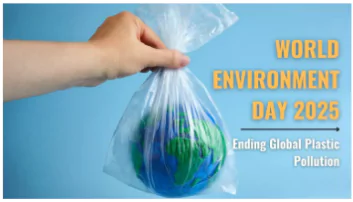On occasion of World Environment Day 2025, the Centre for Science and Environment (CSE) and Down To Earth (DTE) have released State of India’s Environment in Figures 2025.
State of India’s Environment in Figures 2025
- The report paints a grim picture of India’s environmental degradation, public health challenges, and economic disparities, underscoring the urgent need for policy interventions.
- Based on 48 indicators across four themes: Environment, Agriculture, Public Health, Human Development.
- No state/UT excels across all domains; performance is uneven and concerning.
- Emphasis on using publicly available government data to assess progress.
Environmental Crisis
- 2024 was India’s warmest year on record, with 25 states experiencing unprecedented rainfall.
- Climate Migration: Extreme weather events occurred on 88% of days in 2024, leading to 5.4 million internal displacements, nearly half in Assam alone .
- Floods accounted for two-thirds of displacements, marking the highest climate-linked migration since 2013.
- Greenhouse Gas Emissions: India’s share of global emissions reached 7.8% in 2023, the highest since 1970 .
- The growth rate of emissions accelerated, increasing by nearly 1 percentage point between 2020 and 2023.
- Forest Loss: 29,000 hectares of forestland were diverted in 2023-24, the highest in a decade, mostly in Jharkhand and Uttar Pradesh .
- Wildlife Crisis: Human-animal conflicts surged, with elephant attacks causing 36% more deaths (2020-23 vs. 2023-24) and tiger attacks killing 82 people .
- Toxic heavy metals found in ~50% of monitored river sites (2022).
- E-waste surged by 147% in 7 years; plastic waste hit 4.14 million tonnes (2022–23).
Agriculture and Land Use
- Sikkim Leads in organic farming and sustainable land-use practices.
- But it lags in farmer welfare, highlighting imbalance in development.
- Groundwater Depletion: 135 districts extract groundwater from >40 metres — nearly double from 2014.
- Indicates unsustainable water use and looming water stress.
Pollution and Public Health Crisis
- Air pollution remains deadly: Residents in 13 capitals, including Delhi, breathed unsafe air one in every three days since 2021.
- Life expectancy is reduced by 8 years in Delhi and 6 years in Lucknow due to poor air quality.
- Healthcare system overburdened: India faces a 36% shortage of community health centres and an 80% deficit in specialists.
- Out-of-pocket health expenditure surged to 45%, with Uttar Pradesh recording two-thirds of health costs borne by individuals.
- India saw 3.06 million excess deaths in 2020-21, six times the official COVID toll.
Economic and Social Vulnerabilities
- Incomes declined for salaried and self-employed workers (2017-2023) when adjusted for inflation.
- 73% of India’s workforce is informal, with over half lacking basic employment protections.
- Gender disparity persists: Only 20% of women are employed full-time, compared to 60% of men.
Recommendations and Suggested Measures
- Strengthen climate adaptation strategies to mitigate displacement and extreme weather impacts.
- The National Action Plan on Climate Change (NAPCC) includes 8 missions (e.g., Solar Mission, Green India Mission) to reduce emissions and enhance resilience.
- Enhance pollution control measures, including stricter enforcement of waste management laws.
- Rwanda’s ban on non-biodegradable plastics (2008) led to cleaner cities and boosted eco-tourism.
- Boost healthcare infrastructure and reduce out-of-pocket expenses through universal health coverage.
- Pradhan Mantri Jan Arogya Yojana (PM-JAY) covers 500 million poor for hospitalization, reducing out-of-pocket expenses by up to 60%.
- Formalize the workforce and ensure social security for informal workers.
- Extend social security to gig workers via Code on Social Security (2020), promote digital wage payments (e.g., DBT for MGNREGA)
- Improve data transparency to enable evidence-based policymaking.
World Environment Day

- World Environment Day is celebrated every year on June 5.
- It was established in 1972 during the United Nations Conference on the Human Environment held in Stockholm.
- The first celebration took place in 1973 with the theme “Only One Earth,”.
- It is led by the United Nations Environment Programme (UNEP).
- Theme: The theme of the World Environment Day 2025 is “Beat Plastic Pollution”
- Host: The 2025 host of the World Environment Day is the Republic of Korea (South Korea).
|
Conclusion
The State of India’s Environment in Figures 2025 serves as a critical wake-up call. While India has made progress in several areas, the worsening climate, health, and economic indicators demand urgent action. Policymakers must prioritize sustainable development, equitable growth, and environmental conservation to secure a resilient future for the nation.
![]() 5 Jun 2025
5 Jun 2025

